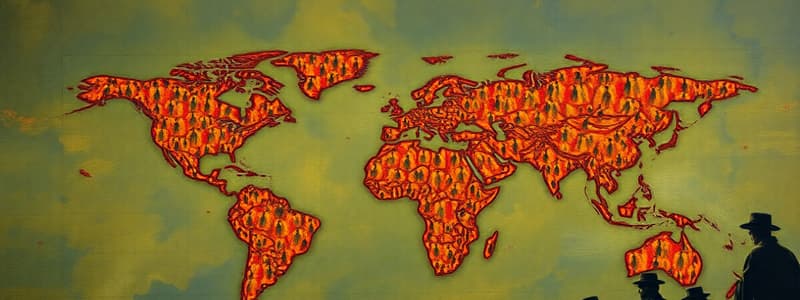Podcast
Questions and Answers
What are the primary factors that contribute to the uneven distribution of the world population?
What are the primary factors that contribute to the uneven distribution of the world population?
Geographical features, economic opportunities, and historical migration patterns are primary factors contributing to the uneven distribution of the world population.
Explain how population density can be misleading when ranking countries.
Explain how population density can be misleading when ranking countries.
Population density can be misleading due to the high densities of microstates and city-states, which distort comparisons with larger countries that may have vast, sparsely populated areas.
How is the rate of natural increase calculated, and what does it indicate about a population?
How is the rate of natural increase calculated, and what does it indicate about a population?
The rate of natural increase is calculated by subtracting the death rate from the birth rate, indicating how fast a population is growing or declining.
Which country has the highest population density when excluding microstates, and what is its density?
Which country has the highest population density when excluding microstates, and what is its density?
What role do China and India play in the global population distribution?
What role do China and India play in the global population distribution?
What does a population pyramid with a wide base and narrow top signify about a country's demographic trends?
What does a population pyramid with a wide base and narrow top signify about a country's demographic trends?
How is the total fertility rate (TFR) significant in understanding a country's population dynamics?
How is the total fertility rate (TFR) significant in understanding a country's population dynamics?
Explain the concept of natural increase in relation to population change.
Explain the concept of natural increase in relation to population change.
What does a population pyramid that resembles a column reveal about a nation's growth trends?
What does a population pyramid that resembles a column reveal about a nation's growth trends?
How do immigration and emigration contribute to the net migration rate of a country?
How do immigration and emigration contribute to the net migration rate of a country?
Flashcards are hidden until you start studying
Study Notes
Population Geography
- Population geography studies the spatial distribution of human populations.
- It examines population characteristics of specific regions and places.
- The field focuses on population growth, decline, and migration patterns.
Global Population Distribution & Density
- The world's population is approximately 7.7 billion people.
- Population distribution is uneven across the 193 UN member countries.
- China and India account for over 1/3 of the global population.
- The seven most populous countries (China, India, USA, Indonesia, Brazil, Pakistan, and Nigeria) account for over half of the world's population.
- Population density is a useful statistic for understanding population distribution, but it needs careful consideration due to the complexities of microstates, city-states, and small island countries.
- Bangladesh, excluding microstates, is the most densely populated country with over 3,200 people per square mile.
- Russia, despite being the largest country by land area, has a low population density with slightly over 23 people per square mile.
Population Change
- The rate of natural increase examines population change through births and deaths.
- The birth rate reflects the number of children born per thousand people annually in a country.
- The death rate reflects the number of deaths per thousand people annually.
- The population pyramid is a tool used by geographers to visually analyze population distribution across different age brackets.
- A wide base and narrow top indicate rapid population growth.
- A narrow base and wide top suggest declining population.
- A column-shaped pyramid signifies slow or no population growth.
- The total fertility rate (TFR) is similar to the birth rate, reflecting the average number of children a female will have during her lifetime.
Migration Influences
- Immigration refers to the entry of migrants into a country.
- Emigration is the departure of migrants from a country.
- The net migration rate is the difference between annual immigrants and emigrants, per thousand people.
- Both immigration/emigration heavily impact a country's population growth.
Studying That Suits You
Use AI to generate personalized quizzes and flashcards to suit your learning preferences.



